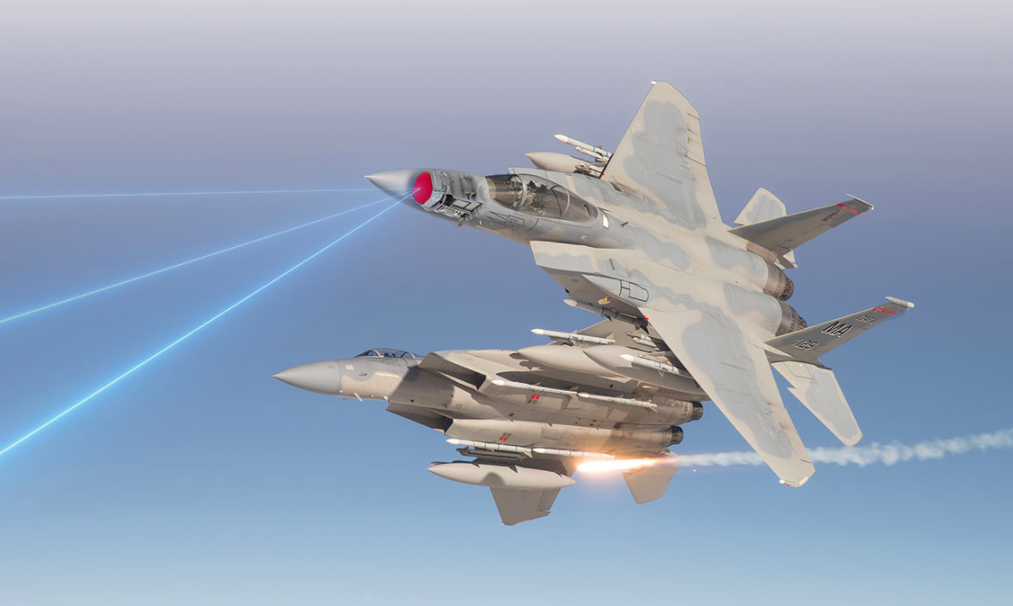
Air Force F-15Es carry Raytheon’s APG-V(1) AESA radar, which also will equip the initial eight F-15EX fighters. Raytheon image.
WASHINGTON: Air Force Research Laboratory is seeking AI capabilities to help analysts more rapidly pinpoint and/or disable jamming in the ‘noisy’ battlefields of the future — as well as specific algorithms to enhance the F-15 fighter jet’s electronic warfare capabilities.
“At least to begin with, we expect the AI to accomplish what the analysts have been doing, but faster,” an AFRL spokesperson said in an email. “AI will augment our existing systems and help automate processes to analyze unfamiliar signals, determine potential sources, and employ adequate countermeasures when needed.
“Currently, we depend on personnel at the reprogramming center to analyze lots of data and postulate future changes to signals and systems, but we need to speed that whole process up to deal with future systems,” the spokesperson added.
Today was the final day for interested vendors to respond to the March 11 request for information (RFI) seeking “cognitive (artificial intelligence/machine learning [AI/ML]) algorithms to advance the capabilities of airborne electronic warfare (EW) systems in development/production.”
In particular, the RFI says the F-15 Program Office is interested in finding technologies “that can be fielded in the next two years and incrementally improved upon and integrated into EW systems currently in development for the F-15.”
The Air Force currently is developing the he Eagle Passive Active Warning Survivability System (EPAWSS) EW suite for the F-15E and the new F-15EX, which will enable pilots to monitor, jam, and deceive enemy air defenses. Under current Air Force plans, a total of 217 F-15E model aircraft could be modernized with the EPAWSS system — a number that could include up to 144 F-15EX models. (EPAWSS has a somewhat roiled history tied to shifting service plans for upgrading the F-15E.)
F-15 prime contractor Boeing last month awarded BAE Systems a $58 million contract to begin low-rate initial production (LRIP) of the electronic warfare suite for the F-15EX. The plan is for BAE to continue to deliver incremental upgrades to the EPAWSS software, including improved geolocation and threat identification capabilities.
The Air Force last April started testing EPAWSS at Edwards AFB in California — including work to ensure compatibility with other radio-frequency using subsystems such as the Raytheon AN/APG-82 radar.
The new EW RFI, however, is short, decidedly vague and doesn’t mention EPAWSS, so it is unclear how or even if the two are directly related.
“The RFI was written in a vague way to allow for maximum flexibility and creativity. We wanted to state the problem to be solved, and little more,” the spokesperson said. Further, the spokesperson added, delving into the details quickly crosses the line into classified territory.
The gist of the problem AFRL is looking to fix is that radar systems used to detect airborne threats are rapidly evolving, as are the capabilities to jam those devices. The Global Positioning System satellite signals providing positioning, timing and navigation for everything from troops on the move to guiding advanced missiles to their targets also are increasingly vulnerable.
“We recognize that future radars will have the ability to rapidly change and employ waveforms and patterns not previously used, so we are asking for ideas to address that issue,” the AFRL spokesperson said. (‘Changing waveforms’ can mean simple frequency hopping or “changing in many parameters at once,” the spokesperson noted.)
Further, many more civilian-use electronic devices now emit radio signals, such as wireless devices — hence the fierce debate over whether a new 5G wireless phone network planned by Ligado will null GPS receivers near its broadcast towers. Air Force signals specialists will need to figure out whether interference with military systems is intentional or not, and what to do about it.
“The intent is to build flexibility into the system to enable appropriate characterization-of and responses-to various emitters,” the spokesperson said.
According to the RFI, the Air Force is seeking vendors “with strong EW experience and algorithms/technologies that provide the capability for EW systems to more rapidly and intelligently respond to emitter ambiguities, emerging threats, in both sparse and dense signal environments.”
"Electronic" - Google News
April 12, 2021 at 10:10PM
https://ift.tt/3tdRWOv
Electronic Warfare Apps On Horizon For F-15s, Plus - Breaking Defense
"Electronic" - Google News
https://ift.tt/3dmroCo
https://ift.tt/3bbj3jq
No comments:
Post a Comment